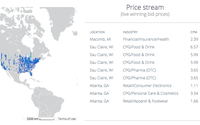Commentary
Lag Time With Index Exchange
- by Joe Mandese @mp_joemandese, December 4, 2015

Normally, I don’t like to use this blog to grouse about the behind-the-scenes ops of one of our sources, but it’s rare that I have this kind of opportunity to share with you how one them operates. More importantly, I think it’s instructive of the value of data, analytics, information and especially time, in what we keep telling ourselves is a “real-time” business. Or in this case, of the Index Exchange’s analytics team, not so much.
On Thursday the Index Exchange released its “Q2 Quarterly Report” on U.S. programmatic market trading. What’s wrong with that? They released it near the end of Q4. So much for real-time analytics and insights.
Ordinarily, I’d just chalk that up to latency, process, organizational workflow, etc., because the truth is we normally have no idea how organizations like the Index Exchange analyze and produce these reports. Except in this case, they brought us into the process -- back in July -- when they said they would have their Q2 report in “two weeks.” It’s now December.
The reason for the dig isn’t just because they misrepresented themselves to us, it’s that they provided us with the ammo to expose their process to others. Don’t get me wrong, a four-month-plus lag time on ad-industry marketplace reports is not that unusual. We always assumed it takes that long to get the data, organize and process it. In this case, that’s not what happened. Even worse, Index Exchange prides itself being a real-time operation, capable of advising its clients and their customers on virtually instantaneous trading, latent by nanoseconds at best.
Even more ironic is that
you can go on their website and see “live winning bid prices” streaming in real-time, including a nifty heat map of North American ebbing and flowing with the activity. I’m looking
at it now as I write this post and I can’t even keep pace with the bid data streaming through, because it’s moving faster than I can record it for you. So I did the next best thing and
capt ured a screenshot so you can see if for yourself. Or just go to their site and see it for yourself.
ured a screenshot so you can see if for yourself. Or just go to their site and see it for yourself.
So the real reason for this post is that I’m not just disappointed by the way Index Exchange handled their Q2 marketplace report. I’m truly shocked by the lag time it took to produce it. It’s just not in keeping with their brand.
As for the findings of the report itself, well, go download it and read it yourself if you want.
By this point, I’m sure most of our readers are more interested in the third quarter or even the fourth. I mean, the notion of quarterly reports in a real-time programmatic trading marketplace is sort of absurd to begin with, but in truth, there is a lot of value in looking at market data longitudinally over longer periods of time, because it does give you perspective you can’t see by looking at real-time bid data. And most of the biggies -- Rubicon Project, PubMatic, Accordant Media -- still produce them that way.
Speaking of which, I did have an opportunity to chat the other day with PubMatic’s Rajeev Goel about its third-quarter findings. The company provides a fascinating snapshot over some recent marketplace trending, especially the stratification of “premium” and less-than-premium markets and inventory.
The most interesting shift, Goel says, is the one taking place with mobile inventory -- both mobile vs. desktop, as well as mobile Web optimized vs. non-optimized inventory.
“Maybe the most interesting thing we’ve seen in the last several months, is that we’ve closed the mobile gap,” Goel said, noting that programmatic marketplace demand has finally caught up with consumer usage levels of mobile vs. desktop.
For the first time, he said mobile programmatic inventory yielded higher CPMs than desktop during the third quarter of 2015.
According to PubMatic’s tracking, he said, mobile programmatic inventory revenues rose 200% year-over-year and yielded an average price that was 34% higher than desktop programmatic inventory during the third quarter.
Noting that both sources are growing at double-digit rates, Goel said mobile CPMs are growing faster and should continue to increase its spread vs. desktop for the foreseeable future.
Mostly, he said it’s because of the availability of quality inventory, the fact that brands now recognize a shift in consumer behavior toward mobile, and that mobile -- especially mobile-optimized inventory -- is becoming a proxy for “premium” value in the marketplace.
“We’re seeing the supply changing rapidly, with big shifts toward mobile-optimized experiences -- in-app, but also mobile Web, because publishers are changing the way they optimize their sites for mobile.”
What does that mean in terms of the bottom line? According to Goel, CPMs for mobile-optimized website inventory rose 48% during the third quarter, but CPMs for non-optimized website inventory fell by 26%.”
“There’s a stratification taking place in premium value,” he said.


